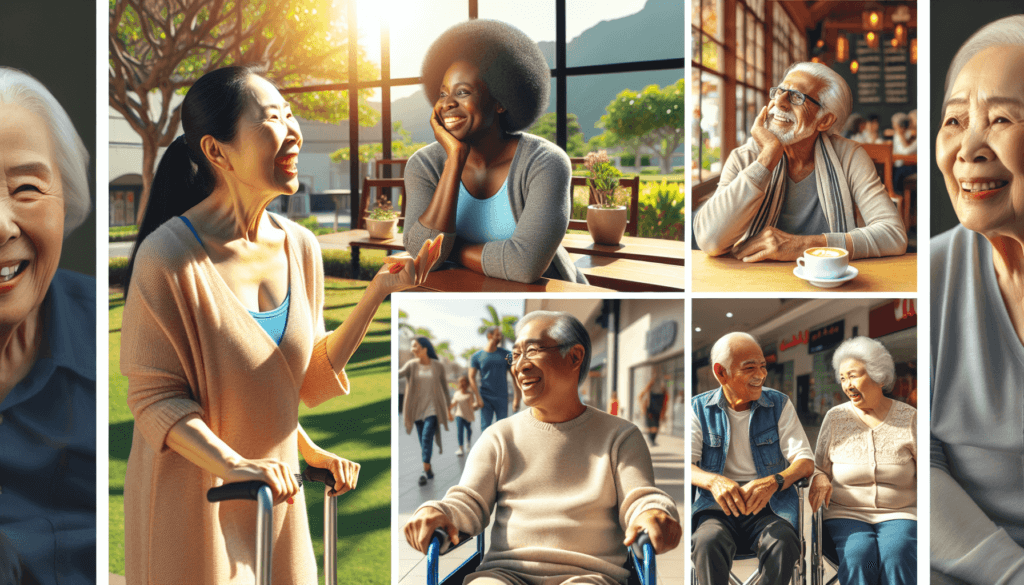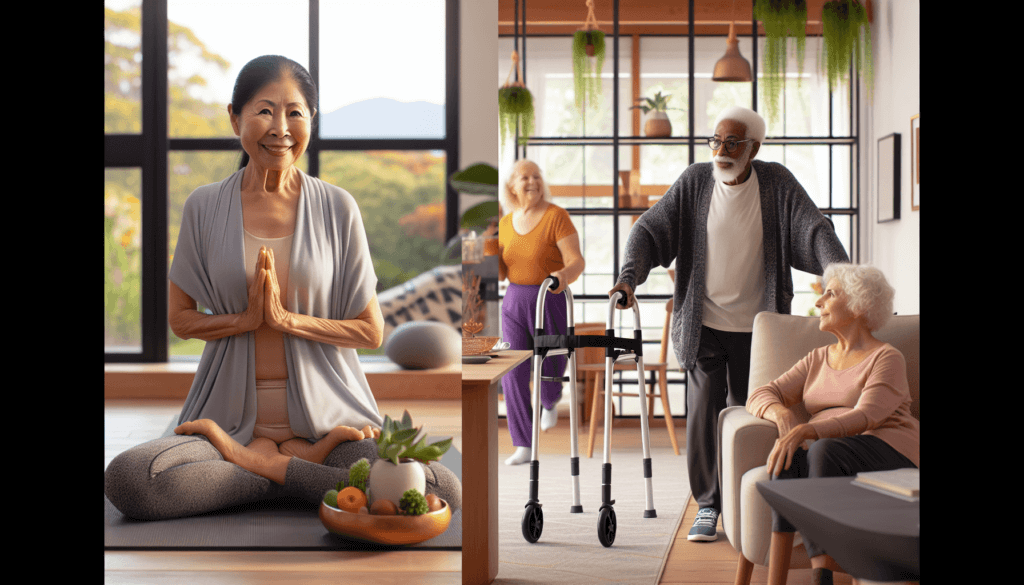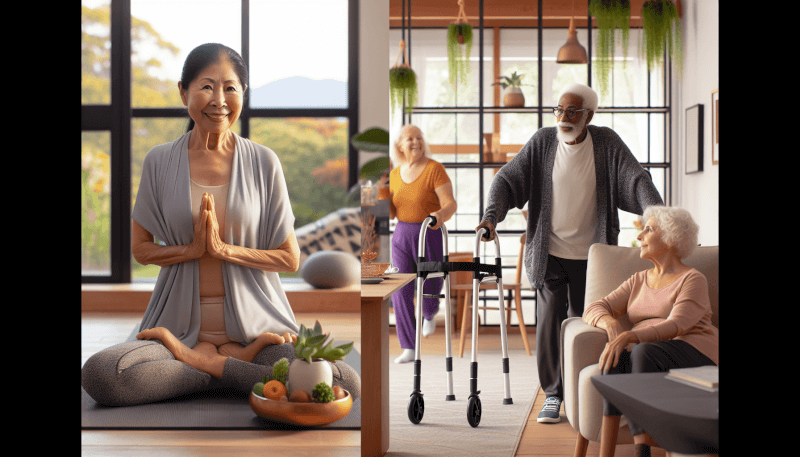As you age, maintaining your independence and mobility becomes increasingly important. It allows you to continue enjoying the activities and lifestyle you love, without having to rely on others. Fortunately, there are numerous ways to ensure that you remain independent and mobile as you get older. From staying physically active and engaging in regular exercise, to practicing good balance and flexibility exercises, to utilizing assistive devices when necessary, this article will provide you with valuable tips and insights on how to maintain your independence and mobility as you age. So keep on reading, and discover how you can continue living life to the fullest, regardless of your age.

Taking Care of Physical Health
Engaging in regular exercise
Maintaining physical health is crucial to maintaining independence and mobility as you age. Engaging in regular exercise is one of the most effective ways to keep your body strong and flexible. You don’t have to run marathons or lift heavy weights to stay active. Simple activities like walking, swimming, or yoga can have a significant impact on your overall health. Aim for at least 30 minutes of moderate exercise most days of the week. Additionally, don’t forget to warm up before exercising and cool down afterward to prevent injuries.
Maintaining a balanced diet
Another key aspect of physical health is maintaining a balanced diet. A healthy diet can help prevent chronic diseases, boost your immune system, and provide your body with the nutrients it needs to function properly. Include a variety of fruits, vegetables, whole grains, lean proteins, and healthy fats in your meals. Limit your intake of processed foods, sugary drinks, and unhealthy snacks. It’s also important to stay hydrated by drinking plenty of water throughout the day.
Getting regular check-ups and screenings
Regular check-ups and screenings are important for early detection and prevention of health issues. Schedule regular appointments with your healthcare provider to monitor your overall health and address any concerns. Make sure to get the recommended screenings, such as mammograms, colonoscopies, and bone density tests, as recommended by your doctor. These screenings can help detect potential problems early on and increase the chances of successful treatment.
Managing chronic conditions effectively
For many older adults, managing chronic conditions becomes a part of daily life. It’s essential to work closely with your healthcare provider to effectively manage your conditions. Follow your doctor’s recommendations for medication, treatment, and lifestyle changes. Take your medications as prescribed, monitor your symptoms, and report any changes or concerns to your healthcare provider. By managing your chronic conditions effectively, you can minimize their impact on your daily life and maintain your independence.
Ensuring proper medications and treatments
In addition to managing chronic conditions, it’s important to ensure you have access to the proper medications and treatments. Take the time to understand your medications, including their purpose, dosage, and potential side effects. Keep track of your medications and take them as prescribed. If you have difficulty managing your medications, consider using pill organizers or ask a trusted family member or friend for assistance. Additionally, follow through with any recommended treatments, such as physical therapy or rehabilitation, to optimize your health and mobility.
Promoting Mental Well-being
Staying socially active
Maintaining social connections is essential for your mental well-being as you age. Stay socially active by spending time with family and friends, joining clubs or organizations, participating in community activities, or volunteering for a cause you’re passionate about. Engaging in social activities can help prevent feelings of loneliness or isolation and promote a sense of belonging and purpose.
Engaging in brain-stimulating activities
Keeping your mind sharp is key to maintaining mental well-being and independence. Engage in brain-stimulating activities such as reading, puzzles, crosswords, or learning new skills or hobbies. These activities can help improve memory, cognitive function, and overall brain health. Consider taking classes or online courses to continue learning and challenging your mind.
Seeking emotional support and counseling
It’s important to prioritize your emotional well-being as you age. Don’t hesitate to seek emotional support or counseling if you’re feeling overwhelmed, anxious, or depressed. Talking to a trusted friend, family member, or therapist can provide valuable support and guidance. They can help you navigate life changes, cope with stressors, and develop healthy coping mechanisms.
Maintaining a positive outlook
Maintaining a positive outlook can greatly contribute to your mental well-being and overall happiness. Focus on the positive aspects of your life and practice gratitude for the things you have. Surround yourself with positive influences and avoid negative or toxic relationships. Cultivate a mindset of optimism and resilience, and don’t be afraid to seek professional help if negative thoughts or emotions become overwhelming.
Practicing stress management techniques
As you age, it’s important to develop effective stress management techniques. Chronic stress can have negative effects on both your physical and mental health. Explore different stress management techniques that work for you, such as deep breathing exercises, meditation, yoga, or engaging in hobbies that help you relax. Prioritize self-care and make time for activities that help you unwind and rejuvenate.
Creating a Safe Living Environment
Removing potential hazards
Creating a safe living environment is essential for maintaining independence and mobility. Start by removing potential hazards from your home. Ensure that walkways are clear of clutter and obstacles. Secure rugs or remove them entirely to prevent trips or falls. Install handrails along staircases and grab bars in bathrooms to provide stability and prevent accidents. Regularly check for and address any loose wires, uneven flooring, or other potential hazards.
Installing assistive devices
Assistive devices can greatly enhance your safety and independence at home. Consider installing devices such as handrails, grab bars, or shower seats to assist with mobility in the bathroom. Use elevated toilet seats or commodes if necessary. In the kitchen, make use of reachers or long-handled utensils to access items without straining. Explore options such as stairlifts or elevators if navigating stairs becomes challenging.
Adapting the home for easier mobility
Adapting your home for easier mobility can make a significant difference in your daily life. Consider widening doorways to accommodate wheelchairs or walkers if needed. Install ramps or lifts for easy access in and out of the house. Place essentials like toiletries and kitchen items within easy reach. Rearrange furniture to create clear pathways and remove any unnecessary obstacles.
Utilizing smart technology for safety
Smart technology can provide added safety and peace of mind as you age. Install motion sensor lights that automatically turn on when you enter a room or hallway. Utilize smart home security systems that allow you to monitor your home remotely and receive alerts for any unusual activity. Consider using wearable devices with emergency call buttons or fall detection features to summon help if needed.
Ensuring proper lighting and visibility
Good lighting is essential for safe and independent living. Ensure that all areas of your home are well-lit, especially staircases, hallways, and entrances. Use bright, overhead lights, and consider installing nightlights to provide illumination during nighttime hours. Use high-contrast colors for essential items like light switches, door handles, and stair nosings to improve visibility and reduce the risk of accidents.
Using Mobility Aids and Devices
Using walking aids like canes or walkers
Walking aids such as canes or walkers can provide additional support and stability when walking. Consult with a healthcare professional to determine the appropriate walking aid for your specific needs. Learn how to use the aid correctly and practice proper posture and technique. Regularly check the condition of your walking aid and replace any worn out or damaged parts.
Employing wheelchairs or scooters
If walking becomes challenging, using a wheelchair or scooter can help maintain your mobility. There are various types of wheelchairs and scooters available, ranging from manual to electric-powered options. Consult with a healthcare professional or mobility specialist to determine the most suitable option for your needs. Learn how to operate the wheelchair or scooter safely and practice utilizing it in different environments.
Using grab bars and handrails
To assist with balance and stability, installing grab bars and handrails throughout your home is essential. These devices can be particularly useful in bathrooms, near stairs, and in areas where you may need support when standing up or sitting down. Make sure the grab bars and handrails are securely installed and can support your weight. If needed, consider seeking professional help for proper installation.
Utilizing stairlifts or elevators
Navigating stairs can become increasingly challenging as you age. Installing a stairlift or elevator can allow you to safely and easily access multiple levels of your home. Consult with a professional to assess your home’s layout and determine the most suitable option. Ensure that the stairlift or elevator is regularly inspected and serviced to maintain its optimal functionality.
Using modified vehicles for transportation
Maintaining independence and mobility outside of your home may require modified vehicles for transportation. Consider consulting with a mobility specialist or occupational therapist who can help assess your specific needs. Options may include modified cars with hand controls, wheelchair-accessible vans, or scooter carriers for vehicles. Explore available resources and funding options, such as government programs or grants, to assist with the cost of modifications.

Maintaining Personal Hygiene and Self-Care
Adapting bathing and grooming techniques
As mobility may become more challenging, adapting bathing and grooming techniques can help maintain personal hygiene. Install hand-held showerheads and shower chairs to make bathing more accessible. Use long-handled brushes or sponges to reach areas that may be difficult to access. Explore alternatives to traditional bathing, such as sponge baths or dry shampoos, if necessary. Seek assistance from caregivers or family members if needed.
Using aids for personal hygiene
Various aids are available to assist with personal hygiene tasks. Long-handled reachers can help with putting on socks or shoes. Grab bars installed near toilets can provide stability and support. Consider using raised toilet seats or commodes for easier access. Utilize adaptive tools such as electric toothbrushes or flossers for dental hygiene. These aids can enhance your ability to maintain personal hygiene independently.
Maintaining regular dental hygiene
Maintaining good dental hygiene is crucial for overall health and well-being. Brush your teeth twice a day using a soft-bristled toothbrush and fluoride toothpaste. Floss daily to remove plaque and prevent gum disease. Schedule regular dental check-ups and cleanings to address any potential issues early on. If necessary, explore options such as electric toothbrushes or water flossers to make dental hygiene tasks more manageable.
Promoting a healthy sleep routine
Adequate sleep is essential for maintaining optimal physical and mental health. Establish a consistent sleep routine by going to bed and waking up at the same time each day. Create a calm and comfortable sleeping environment by maintaining a cool temperature, using blackout curtains, and using a supportive mattress and pillows. Avoid stimulants like caffeine close to bedtime, and engage in relaxing activities before sleep, such as reading or taking a warm bath.
Practicing good posture and body mechanics
Maintaining good posture and using proper body mechanics can minimize the risk of injuries and maintain your mobility. Sit and stand with your back straight and shoulders relaxed. Avoid slouching or hunching over. When lifting or carrying objects, use your leg muscles and keep your back straight. Avoid twisting your body excessively when reaching for objects. By practicing good posture and body mechanics, you can reduce strain on your muscles and joints.
Improving Home Safety
Ensuring proper fire safety measures
Home safety includes being prepared for emergencies such as fires. Install smoke detectors on each level of your home and regularly test their functionality. Have fire extinguishers readily available and ensure all household members know how to use them. Create and practice a fire escape plan, including identifying escape routes and a designated meeting place. If necessary, consider installing fire sprinkler systems for additional safety.
Implementing fall prevention strategies
Falls are a common concern as you age, but implementing fall prevention strategies can help reduce the risk. Keep walkways and floors clear of clutter, rugs, or loose cords. Use non-slip mats or rugs in bathrooms and entryways. Install handrails or grab bars near stairs and in areas where balance support is needed. Ensure adequate lighting throughout the house, especially in hallways and staircases. Regular exercise and strength training can also improve balance and reduce the likelihood of falls.
Securing doors and windows
Ensuring the security of your home is essential for your personal safety and peace of mind. Install sturdy locks on all doors and windows and regularly check their functionality. Consider using security alarms or surveillance systems to deter unwanted intrusions. Install peepholes on doors to identify visitors before opening. Keep doors and windows locked when you’re away from home, and be cautious when answering the door to unknown individuals.
Using medical alert systems
Medical alert systems provide an added layer of safety, particularly if you live alone or have specific health concerns. These systems typically include a wearable device with an emergency button that, when pressed, alerts a monitoring center or designated contacts. This ensures immediate assistance can be provided in case of emergencies. Research different medical alert systems available and choose one that suits your specific needs and preferences.
Keeping emergency contacts handy
In case of emergencies, it’s important to have essential contact information readily available. Keep a list of emergency contacts near your phone or programmed into your phone’s contacts. Include the numbers for local emergency services, family members, neighbors, and healthcare providers. Provide a copy of this list to a trusted family member or friend as a backup. Make sure the list is updated regularly to ensure accurate and reliable contact information.

Utilizing Transportation Services
Using public transportation
Public transportation can be an excellent option for maintaining independence and mobility when driving is no longer feasible. Familiarize yourself with local public transportation options, such as buses, trains, or subways. Research schedules, route maps, and accessibility features, such as ramps or designated seating. Consider obtaining a senior citizen or disability pass that may offer reduced fares or additional benefits.
Utilizing senior citizen transportation services
Many communities offer specialized transportation services for senior citizens. These services often provide door-to-door transportation for medical appointments, grocery shopping, or other essential needs. Research local senior citizen transportation services and find out if you’re eligible. These services can be particularly useful if you have mobility limitations or difficulty accessing public transportation.
Exploring ride-sharing apps
Ride-sharing apps like Uber or Lyft can provide convenience and flexibility when it comes to transportation. These apps allow you to request rides at your convenience and provide door-to-door service. Explore ride-sharing apps and familiarize yourself with their features and payment options. Some apps even offer options specifically tailored for older adults, such as accessible vehicles or the ability to request assistance with carrying groceries.
Considering medical transportation options
If you require specialized medical transportation, there are options available to meet your needs. Medical transportation services provide transportation to medical appointments, therapies, or hospital visits. These services often have specialized vehicles equipped with medical equipment and personnel trained to handle specific medical conditions. Consult with your healthcare provider or insurance provider to explore medical transportation options in your area.
Arranging regular visits to healthcare providers
Regular visits to healthcare providers are essential for maintaining your health and well-being. Arrange for transportation to and from your appointments to ensure regular check-ups and necessary treatments are not missed. Explore different transportation options discussed earlier to find the most suitable and convenient method. Prioritize your health by scheduling appointments in advance and planning transportation accordingly.
Hiring In-Home Care and Assistance
Getting help with household chores
As you age, household chores can become physically challenging, and getting help with these tasks can greatly support your independence and well-being. Consider hiring help with tasks such as cleaning, laundry, meal preparation, or gardening. If hiring assistance is not an option, explore community resources or reach out to local organizations that offer volunteer services for older adults.
Hiring personal care aides
Personal care aides provide assistance with activities of daily living, such as bathing, dressing, grooming, or medication management. Hiring a personal care aide can help maintain your personal hygiene and allow you to continue living independently. Research reputable home care agencies in your area and thoroughly vet potential candidates to ensure they are qualified, trustworthy, and compatible with your needs.
Arranging for home healthcare services
Home healthcare services provide professional medical care in the comfort of your own home. These services range from skilled nursing care to physical therapy, wound care, or medication management. Consult with your healthcare provider to determine if home healthcare services are appropriate for your specific needs. Work with a reputable home healthcare agency to ensure you receive quality care and support.
Utilizing respite care for caregiver relief
If you have a caregiver who provides you with support, it’s important to consider their well-being as well. Utilize respite care services to give your caregiver a break and prevent burnout. Respite care provides temporary relief for caregivers and allows them to recharge and attend to their own needs. Respite care can be arranged through home care agencies or support organizations for caregivers.
Considering assisted living communities
Assisted living communities offer a supportive and engaging environment for older adults who require assistance with daily activities but desire to maintain their independence. These communities provide various levels of care and support, including assistance with personal care, medication management, and housekeeping. Consider visiting and exploring different assisted living communities to find one that aligns with your preferences and needs.

Planning for Financial Security
Ensuring a stable income source
Financial security is crucial for maintaining independence and quality of life as you age. Ensure you have a stable income source to cover your living expenses and support your desired lifestyle. Consider options such as pensions, savings, investments, or retirement accounts. Consult with a financial advisor to help you assess your financial situation and create a plan to ensure a stable income during retirement.
Managing expenses effectively
Managing expenses effectively is essential for maintaining financial security. Create a budget that outlines your income and expenses and tracks your spending. Identify areas where you can potentially reduce unnecessary expenses and prioritize essential needs. Regularly review your budget to ensure you’re staying on track and adjusting as needed. Explore resources or workshops that offer financial planning and budgeting assistance.
Creating a retirement savings plan
Creating a retirement savings plan is crucial to ensure financial security as you age. Start saving for retirement as early as possible, even if it’s a small amount. Utilize retirement savings accounts such as IRAs or 401(k)s and take advantage of any employer matching contributions. Consult with a financial advisor to determine the best retirement savings strategies based on your individual circumstances and goals.
Exploring government benefits and entitlements
Government benefits and entitlements can provide additional financial support for older adults. Research programs such as Social Security, Medicare, Medicaid, or veterans’ benefits that you may be eligible for. Understand the eligibility criteria and requirements for each program and consider consulting with a professional who specializes in elder law or benefits planning to ensure you’re maximizing your benefits.
Considering long-term care insurance options
Long-term care insurance can provide financial protection in the event that you require long-term care services in the future. Explore different long-term care insurance options and policies to determine if this type of coverage aligns with your needs and preferences. Consider factors such as premiums, coverage limits, waiting periods, and types of care covered. Consult with a knowledgeable insurance agent who can guide you through the selection process.
Maintaining Active Engagement in Society
Participating in community activities
Staying actively engaged in your community can foster a sense of belonging and purpose. Participate in community activities, events, or groups that align with your interests and values. Attend local cultural events, join clubs or organizations, or volunteer for community service projects. Engaging in community activities can help you form new connections and enhance your overall well-being.
Joining clubs or organizations
Joining clubs or organizations that share similar interests or hobbies can provide opportunities for social interaction and personal growth. Explore clubs dedicated to sports, arts, literature, gardening, or any other field that interests you. These clubs often offer regular meetings, discussions, and activities that allow you to connect with like-minded individuals and pursue your passions.
Volunteering for a cause
Volunteering for a cause you’re passionate about can be a fulfilling and meaningful way to stay active and engaged. Identify organizations or initiatives that align with your values and offer volunteer opportunities. Whether it’s helping at a local food bank, tutoring children, or fostering animals, contributing your time and skills can make a positive impact on others’ lives and provide a sense of purpose.
Continuing education and learning
Never stop learning, regardless of your age. Continuing education can keep your mind sharp, expand your knowledge, and open doors to new opportunities. Consider enrolling in community college courses, attending workshops or seminars, or taking online classes in subjects that interest you. Stay curious and embrace lifelong learning as a way to stay intellectually stimulated and engaged in the world around you.
Exploring new hobbies and interests
As you age, it’s the perfect time to explore new hobbies and interests. Discover activities that inspire you and bring you joy. It could be painting, playing a musical instrument, gardening, cooking, or learning a new language. Engaging in hobbies and interests not only provides enjoyment but can also lead to new friendships and personal growth. Embrace your natural curiosity and pursue activities that make you feel alive.
Maintaining independence and mobility as you age is a multifaceted endeavor. It requires proactive measures to take care of your physical health, promote mental well-being, create a safe living environment, use mobility aids and devices, maintain personal hygiene and self-care, improve home safety, utilize transportation services, hire in-home care and assistance if needed, plan for financial security, and actively engage in society. By incorporating these strategies into your lifestyle, you can enhance your quality of life, remain independent, and enjoy the activities and experiences that bring you fulfillment. Remember, it’s never too late to prioritize your well-being and take the necessary steps to age gracefully and with dignity.



